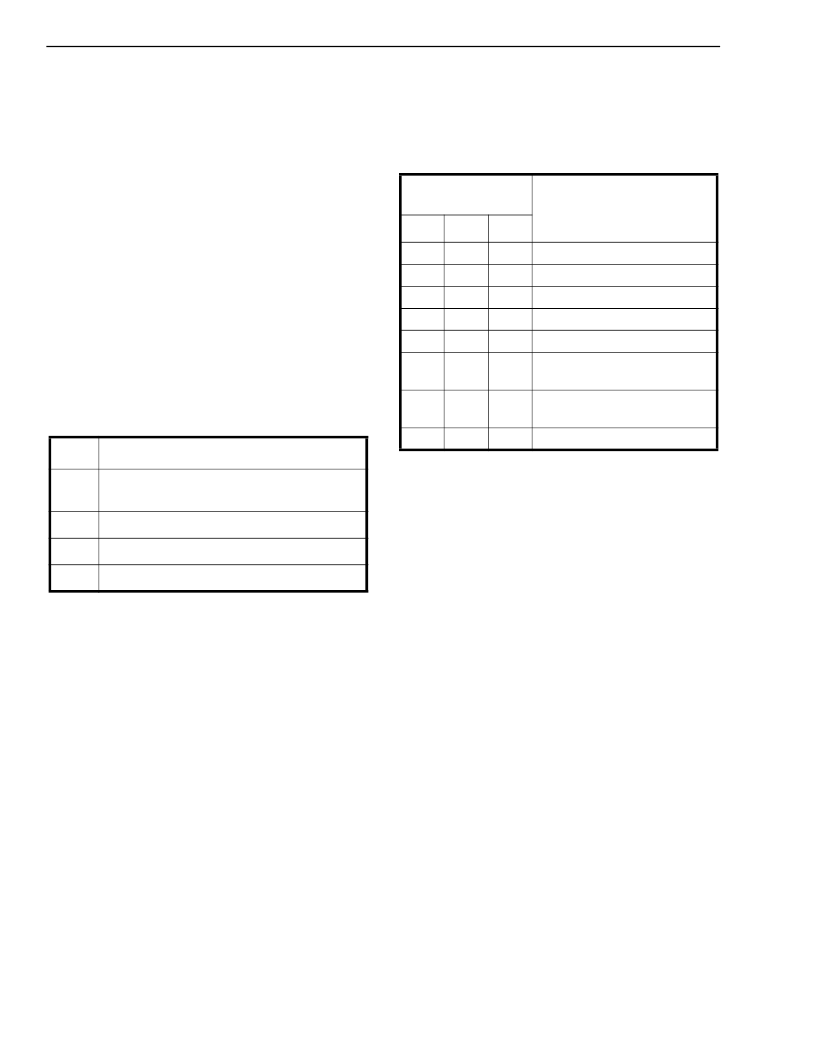- 您現(xiàn)在的位置:買賣IC網(wǎng) > PDF目錄383643 > MT8950AC (Mitel Networks Corporation) ISO-CMOS ST-BUS⑩ FAMILY Data Codec PDF資料下載
參數(shù)資料
| 型號(hào): | MT8950AC |
| 廠商: | Mitel Networks Corporation |
| 元件分類: | Codec |
| 英文描述: | ISO-CMOS ST-BUS⑩ FAMILY Data Codec |
| 中文描述: | 異意法半導(dǎo)體的CMOS總線⑩系列數(shù)據(jù)編解碼器 |
| 文件頁(yè)數(shù): | 8/16頁(yè) |
| 文件大小: | 223K |
| 代理商: | MT8950AC |
第1頁(yè)第2頁(yè)第3頁(yè)第4頁(yè)第5頁(yè)第6頁(yè)第7頁(yè)當(dāng)前第8頁(yè)第9頁(yè)第10頁(yè)第11頁(yè)第12頁(yè)第13頁(yè)第14頁(yè)第15頁(yè)第16頁(yè)

MT8950
ISO-CMOS
6-10
The Secondary Clock input (SCLK) is normally a
600Hz clock signal. This clock is internally aligned
with the 2.048 MHz input. It is used to generate the
synchronizing pulses and the violation word timing
(when the chip is operating in the local carrier mode).
Note that the 600Hz frequency is an exact multiple of
the most commonly used baud rates, i.e., 300, 2400,
4800, 9600, and 19200. In synchronous data
transmission schemes, the receiver timing circuitry
can be kept in sync using the synchronizing pulses
or the violation word when no data is being
transmitted. Other clock frequencies can be used for
specific applications. If this facility is not to be
utilized, the SCLK input can be tied to ground.
Control Interface
An 8 bit word is read into the Control Register via the
CSTi input at the same time as the TEM word is
being shifted in. The chip functions controlled by the
eight bits are summarized in Table 3 and described
in subsequent sections.
Table 3. Summary of Control Register Function
Modes of Operation
As mentioned earlier, the data codec can operate in
eight different modes. The specific mode is selected
through bits 7, 6 and 5 in the Control Register. Table
4 summarizes the different modes.
Mode 0: Normal.
This is the normal transparent
conversion mode of the data codec. The NRZ/RZ
input signal is directly encoded into the TEM format
and output as an ST-BUS channel. The TEM word
for the input ST-BUS channel is decoded and the
regenerated data is output via the NRZ/RZ output
circuitry. Synchronizing pulses are also transmitted
as explained in the preceding paragraphs.
Mode 1: Local Carrier.
In this mode the NRZ/RZ
output circuitry transmits an 8 bit word at D
R
2 (Pin
18) by modulating the secondary clock (SCLK). If
the chip has been selected to operate in the RZ
format,
this
word
is
Violations. The time interval between consecutive
pulses specifies the binary value. A logical zero is
transmitted
as
MARK
Bit
Function
7,6,5
Device mode control bits. These bits
select one of eight modes of operation
4,3,2
Violation word control bits
1
Resets the Data Activity Scan point
0
Resets the Uncommitted Scan point
represented by a time interval of one SCLK period
between the pulses. A logic “1” is represented by
two clock periods. In the NRZ mode, the time
interval between consecutive transitions of the signal
carries the information. The modulation scheme is
illustrated in Figure 6. The 8 bit word consists of a
Table 4. Modes of Operation
sync bit followed by seven other bits. Bits 1, 4 and 5
in this word reflect the values of bits 2, 3 and 4 in the
Control Register. The remaining four bits in the word
are fixed as zeros. The sync bit is identified by a
time interval equal to four clock periods of SCLK.
The NRZ/RZ input circuitry and the encoder stage
operates normally in this mode.
Mode 2: Local Synchronization.
In the local sync
mode, the NRZ/RZ output circuitry transmits only
sync pulses on D
R
2. These sync pulses appear as
MARK violations in the RZ mode with the time
interval between consecutive pulses equal to four
SCLK periods. In the NRZ format D
R
2 outputs a
squarewave with a period equal to eight cycles of
SCLK. D
R
1 output is held at steady MARK. The
NRZ/RZ input circuitry and the encoder stage of the
chip function normally.
Mode 3: Digital Loopback.
In this mode an 8 bit
word from the incoming ST-BUS (DSTi) is sampled
and one ST-BUS frame later, the same word is
looped back to the corresponding outgoing channel
of the ST-BUS (DSTo). This allows the user to test
the ST-BUS transmission path to and from the data
codec.
Mode 4: Data Loopback
. This mode permits the
user to test the decoding and encoding operation of
the codec. A known TEM word is sent to the data
codec from the ST-BUS end. This word is decoded
and redirected via the output circuitry to the NRZ/RZ
input circuit and subsequently to the encoder stage
Control Register
Bits
Mode of Operation
b7
b6
b5
0
0
0
0
0
1
Normal
Local Carrier
0
1
0
Local Synchronization
0
1
1
Digital Loopback
1
1
0
0
0
1
Data Loopback
Data Loopback - Local
Violation Word
Normal Mode - Drive Point
Set HIGH.
Idle
1
1
0
1
1
1
相關(guān)PDF資料 |
PDF描述 |
|---|---|
| MT8952BC | ISO-CMOS ST-BUS⑩ FAMILY HDLC Protocol Controller |
| MT8952BE | ISO-CMOS ST-BUS⑩ FAMILY HDLC Protocol Controller |
| MT8952BP | ISO-CMOS ST-BUS⑩ FAMILY HDLC Protocol Controller |
| MT8952BS | ISO-CMOS ST-BUS⑩ FAMILY HDLC Protocol Controller |
| MT8952 | ISO-CMOS ST-BUS⑩ FAMILY HDLC Protocol Controller |
相關(guān)代理商/技術(shù)參數(shù) |
參數(shù)描述 |
|---|---|
| MT8952 | 制造商:MITEL 制造商全稱:Mitel Networks Corporation 功能描述:ISO-CMOS ST-BUS⑩ FAMILY HDLC Protocol Controller |
| MT8952B | 制造商:MITEL 制造商全稱:Mitel Networks Corporation 功能描述:ISO-CMOS ST-BUS⑩ FAMILY HDLC Protocol Controller |
| MT8952B-1 | 制造商:MITEL 制造商全稱:Mitel Networks Corporation 功能描述:ISO-CMOS ST-BUS⑩ FAMILY HDLC Protocol Controller |
| MT8952BC | 制造商:MITEL 制造商全稱:Mitel Networks Corporation 功能描述:ISO-CMOS ST-BUS⑩ FAMILY HDLC Protocol Controller |
| MT8952BE | 制造商:MITEL 制造商全稱:Mitel Networks Corporation 功能描述:ISO-CMOS ST-BUS⑩ FAMILY HDLC Protocol Controller |
發(fā)布緊急采購(gòu),3分鐘左右您將得到回復(fù)。